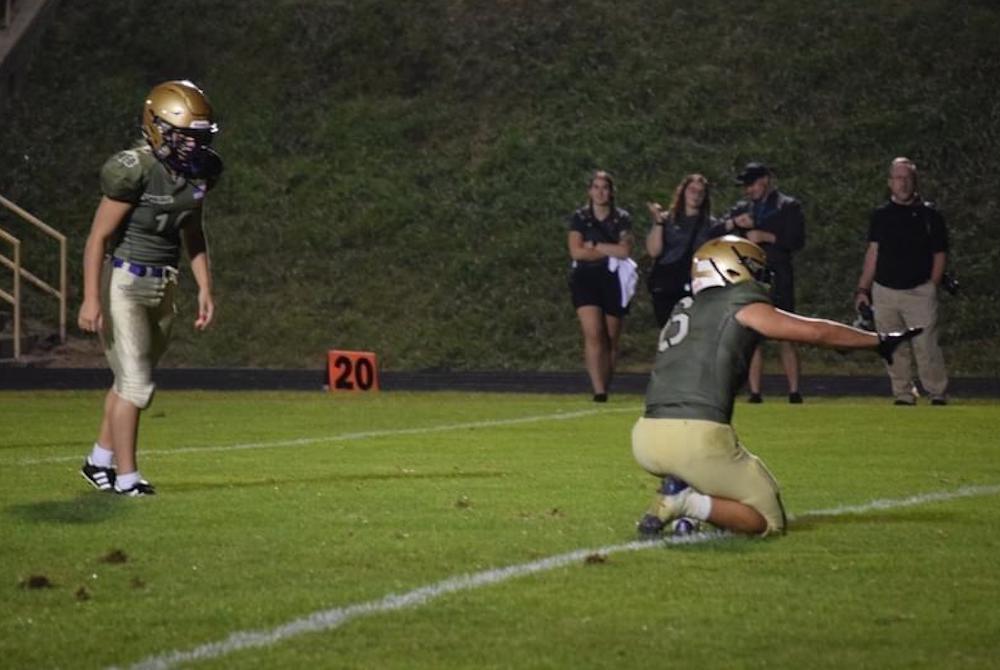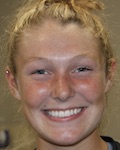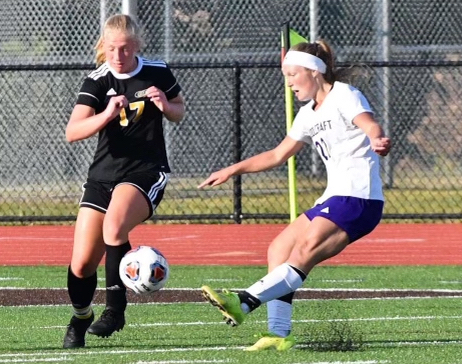
'22 Game' Lasts 2 Plays, Lives on
By
Ron Pesch
MHSAA historian
October 26, 2015
What would you do with 22 seconds to right a wrong?
In Michigan, the longest football game in high school sports history was played on September 23, 1977 when Detroit Southeastern defeated Detroit Northeastern 42-36 in nine overtimes.
But what is the shortest?
On the evening of Thursday, Nov. 5, 1953, Eaton County foes Bellevue and Vermontville squared off in a Tri-C Conference battle. It was a home contest for Vermontville, but without illumination at its field, the game was staged just west beneath the lights at Nashville High School in Barry County.
The dominant team in Tri-C play over the previous three years, Bellevue’s Broncos had posted three consecutive undefeated seasons from 1950 and 1952. However, graduation took its toll and with only five returning veterans in the fall of 1953, Bellevue lost its nonconference season opener to Homer. The Broncos had also dropped a pair of league contests, to Lake Odessa and Olivet, just prior to the Vermontville game, and entered with a 4-3 record.
Vermontville brought a 4-2 mark into the contest, and was in a four-way tie with Bellevue, Nashville and Lake Odessa for second in the conference.
The Broncos and Wildcats were evenly matched and played to a scoreless tie in the first half. Vermontville opened up a 6-0 lead on a 20-yard end sweep by the Wildcats’ quarterback Pete Benton in the third quarter, but entered the final minutes of the game trailing 12-6 thanks to a TD run by Bellevue’s Jim Smith and an early-fourth quarter scoring pass from Smith to Bob Babbitt.
Coach Dave McDowell’s Wildcats mounted a long final drive, and fans strapped in for a thrilling finish. Pushing deep into Bellevue territory, Vermontville faced a fourth down and eight from the 16-yard line with under a minute to play when Benton launched a desperation pass to the end zone.
The pass fell incomplete, but Bellevue was flagged for pass interference. Officials stepped off the penalty and awarded Vermontville the ball at the one-yard line, but the Wildcats’ plunge into the line fell an inch short on what was called a repeated fourth down play. Vermontville took possession and ran out the clock.
Following the game, Coach McDowell protested the ruling to officials, correctly stating that his team should have been awarded an automatic first down and goal from the 1-yard-line on the penalty, according to high school rules. Appealing the call, the situation was brought to the attention of the league, MHSAA executive director Charles Forsythe and the MHSAA athletic board.
On Wednesday, Nov. 11, the state athletic board agreed an error had been made, but did not order a replay. Instead, they noted three possible solutions:
- Result left as it was.
- Called a no contest.
- Replay it at the point of infraction.
The board moved a final decision back to the league. Because of the possible impact on the final conference standings, and eventually, the awarding of the league’s all-sports trophy, the Tri-C Conference opted to replay the contest from the point of infraction – the 1-yard line – with 22 seconds placed on the clock.
 The news of the league’s decision was blasted out by the news services nationwide, and immediately, the pending replay of a small town contest captured the imagination of reporters and sports fans across the United States.
The news of the league’s decision was blasted out by the news services nationwide, and immediately, the pending replay of a small town contest captured the imagination of reporters and sports fans across the United States.
“Shortest ‘Game’ in History?” read the headline in the Lexington, Kentucky Herald. From Biloxi, Mississippi, to Boston, Massachusetts, from Rockford, Illinois to Omaha, Nebraska and Seattle Washington, sports aficionados read the news about the error. Best of all, details flowed forth on the plan to replay critical seconds that might alter the result, fulfilling every fan’s dream.
So began the longest huddle in history.
“What would you do?” was the question on the lips of coaches and followers in barber shops and factories. Detroit Free Press writer George Puscas asked that very question to some of Michigan’s top coaches.
Detroit Lions coach Buddy Parker offered his advice to Vermontville’s coach McDowell.
“The other team will be expecting a run,” noted Parker, “so I would fake a run off tackle then throw a pass in the other direction – with three receivers downfield.”
Michigan State’s legendary Biggie Munn stated the obvious:
“Call a scoring play.”
University of Michigan head coach Bennie Oosterbaan was tied up preparing for the Wolverines’ upcoming contest with MSU, so instead U-M end coach Bill Orwig weighed in with a tongue-in-cheek recommendation:
“Take the time out.”
Earl “Dutch” Clark, in charge at the University of Detroit, suggested that McDowell diagram “two of the most unusual offensive formations … anything to confuse the defense. The first play should be a running play and if it didn’t work, take time out then try again.”
Wayne University’s coach Lou Zarza was the most specific of them all.
“On a goal line stand, the defense usually drifts toward the middle. So I would fake the ball to the right halfback on a slant, then send the fullback with the ball wide to the right, outflanking the defense. It’s a good goal line play on the T formation.”
Suggestions came from all over. A gentleman in Syracuse, New York, even penned a personal letter to McDowell with a sure-fire suggestion.
Three days after the 1953 prep season had officially ended, on the afternoon of Monday, Nov. 16, the same officiating crew and the Vermontville and Bellevue squads emerged and again travelled to Nashville to line up for what can arguably be called the shortest – or perhaps the longest – game in high school football history.
Reporters from Detroit, Grand Rapids, Lansing and Battle Creek converged on the city for 22 seconds of football. High school reporting legends Hal Schram of the Detroit Free Press, Bob Hoerner of the Lansing State Journal, George Maskin of the Detroit Times, Harry Stapler of the Detroit News and writers from the Associated Press and United Press International all descended upon mid-Michigan, “almost as if the Rose Bowl was to be played.”
“That game brought more publicity to coach Gordon Korstange’s 6-3 squad then his teams received for posting three consecutive unbeaten seasons in 1950, 1951 and 1952,” recalled 80-year old Burton H. Brooks, who was the only reporter who had covered the original contest, and one of many covering the replay. A graduate of Bellevue, he was a freshman at Michigan State at the time, earning money as a sports stringer for the Bellevue Gazette and Charlotte Republican Tribune.
Beneath sunny skies, “a crowd of over 500 fans and curiosity seekers, most of them attired in shirt sleeves, lined the field on both sides near the east end of the Nashville gridiron,” wrote Brooks, many years later. “At 5:00 the shrill blast of an official’s whistle split the air, announcing time for the game.”
Attendance was way up from the original contest, and in an unusual move for the time, Kalamazoo television station WKZO announced that they would send a crew to Nashville and then televise the game – (all 22 seconds of it!) – Tuesday evening. In addition, 10 newspaper photographers were on site to capture images from the game.
While the size of the crowd was up, turnout on the football squads had decreased. Vermontville dressed its full squad of 24 for the showdown, but kept out two regular tackles and his first-string quarterback, as all had been on the injured list at the end of the first clash.
Meanwhile, Bellevue brought only 14 players.
“Just our defensive unit and enough to run back the kickoff,” Korstange told the Lansing State Journal, prepared for a situation that could arise if Vermontville scored.
“Three of the defensive starters had decided to go deer hunting instead,” said Brooks discussing the shortened game, “so Bellevue needed to call up some kids for the game from the junior varsity squad.”
“Bellevue won its sixth game of the year, downing Vermontville in a sensational goal line stand in the famous ‘22’ Game” at Nashville last Monday,” wrote Brooks in the Bellevue Gazette. “Coach Dave McDowell’s Wildcats ran two plays against Bellevue, but couldn’t dent the solid Bronco defense. On the first play the Wildcats sent big Bob Steward up center, but he was driven back a yard by the entire center of the Bellevue line.”
 Following a timeout, the Green and White tried to sneak quarterback Pete Benton across the line to the left of center as the ball carrier on the second play, but the hole was quickly plugged by tackle Donald Rogers and guard Jerry Babbitt. Steward had been stopped by Bellevue guard Wayne Lesser. Dale Spotts, Bob Babbitt, Harold Messenger, Ralph Hales, Dick Moon, Jim Smith, Gordon Smith, and Ed Bessemer filled the other defensive spots and ensured the result of the first game went unchanged.
Following a timeout, the Green and White tried to sneak quarterback Pete Benton across the line to the left of center as the ball carrier on the second play, but the hole was quickly plugged by tackle Donald Rogers and guard Jerry Babbitt. Steward had been stopped by Bellevue guard Wayne Lesser. Dale Spotts, Bob Babbitt, Harold Messenger, Ralph Hales, Dick Moon, Jim Smith, Gordon Smith, and Ed Bessemer filled the other defensive spots and ensured the result of the first game went unchanged.
Once again, the wire services blasted their report from sea to shining sea.
“Officials Didn’t Rob Vermontville Team” screamed the headline in the Miami Daily News. Beneath an AP photo, residents of the Florida town were treated to a detailed account of the contest.
“Prep Grid Game Ends Same Way Following 11-Day Break” read the caption in the Dallas Morning News in football-crazed Texas.
“Replayed Grid Game Ends with the Same Result as Before,” read the headline in the Seattle, Washington, Daily Times.
As noted at the time, it certainly wasn’t the first, nor would it be the last, that a refereeing crew made a mistake in a game. Fans then, like now, were reminded officials are only human.
Bellevue ended the extended season in a tie for second with Lake Odessa, with 5-2 marks. For the first time in league history the Tri-C gridiron championship was awarded to Olivet, which, at 8-0, posted its first unbeaten season and, as it turned out, unseated Bellevue for the league’s 1953-54 all-sports trophy.
More than 60 years later, a forgotten showdown between high school football teams, played out before national attention in little Nashville, Michigan, still stands as one of the most entertaining and unusual sports moments in the history of America.
 Ron Pesch has taken an active role in researching the history of MHSAA events since 1985 and began writing for MHSAA Finals programs in 1986, adding additional features and "flashbacks" in 1992. He inherited the title of MHSAA historian from the late Dick Kishpaugh following the 1993-94 school year, and resides in Muskegon. Contact him at [email protected] with ideas for historical articles.
Ron Pesch has taken an active role in researching the history of MHSAA events since 1985 and began writing for MHSAA Finals programs in 1986, adding additional features and "flashbacks" in 1992. He inherited the title of MHSAA historian from the late Dick Kishpaugh following the 1993-94 school year, and resides in Muskegon. Contact him at [email protected] with ideas for historical articles.
PHOTOS: (Top and below) What's believed to be a Battle Creek Enquirer photo shows one of the goal line stands by the Bellevue defense against Vermontville. (Middle) The Lansing State Journal reported on the nationwide reporting of the "22-second game."

Schoolcraft Soccer Record Setter Brings Scoring Touch to Football Field
By
Pam Shebest
Special for MHSAA.com
September 21, 2021
SCHOOLCRAFT — Soccer phenom Hannah Thompson has a flare for finding the net.
 This fall, the Schoolcraft High School senior is aiming even higher – in the most literal sense.
This fall, the Schoolcraft High School senior is aiming even higher – in the most literal sense.
Thompson is the place kicker on the Eagles’ football team, and in the team’s three games so far, she has connected on 4 of 5 point-after attempts.
The first female varsity football player in school history, Thompson is no stranger to breaking records.
Her 87 goals in soccer last spring not only set an MHSAA girls record for most goals in a season, but also eclipsed the boys mark.
Kristi Vandeberghe, a standout at Mount Clemens, had set the previous girls record with 66 goals in 2001. The boys record of 76 goals was set in 2009 by Dearborn’s Soony Saad.
While both sports involve kicking, the vivacious senior said there are differences.
“In soccer, you’re supposed to keep your body over the ball,” she said. “In football, you’re supposed to lean back so the ball goes higher. That’s probably the biggest difference.
“In football, if you try to kick as hard as you can, like for power, the ball can go off to the side. In soccer, you want to kick it hard.”
Head football coach Nathan Ferency, who teaches health and physical education at the high school, had tried to convince Thompson to join the team since she expressed an interest as a freshman.
 “I took my health class outside one spring morning and worked her out a little bit to see if she could kick — and she can actually kick,” he added with a grin.
“I took my health class outside one spring morning and worked her out a little bit to see if she could kick — and she can actually kick,” he added with a grin.
Ferency immediately offered her a spot on the junior varsity team, but since she plays travel hockey in the fall, she opted to concentrate on that until this year.
Her high school soccer coach, Scott Thompson, also her dad, has no problem with her playing football, “and my (soccer) teammates think it’s cool and amazing,” the senior said.
 “They’re very supportive of me. My (travel) coaches do not like it whatsoever. They’re not a fan.”
“They’re very supportive of me. My (travel) coaches do not like it whatsoever. They’re not a fan.”
Her dad sees some positives coming from football.
“As her coach, I have no issues with her playing football,” he said. “She’s working on driving through the ball and working on her leg muscles.
“Being in high school, I didn’t see any issues. As a place kicker, she has minimal opportunities for getting hurt.”
Ferency is aware that soccer is her main interest.
“We’re never going to put her into a kickoff situation where she has to hit somebody,” he said. “We feel comfortable in a PAT or field goal situation where she’s protected and unlikely to have contact.
“We want to preserve her senior year of soccer. That’s her love, and we want to make sure her goals are met.”
Thompson, who has committed to play soccer at Eastern Michigan University, said the hardest part of football is putting on the equipment, especially clipping down the shoulder pads.
“I wear youth large pads so they’re like the middle school pads, and it’s hard to get them clipped down,” she said, laughing while she demonstrated with her hands.
Pads also posed a bit of a problem for her debut.
“The first game, the girdle has the hip pads and the butt pads,” she said. “The pants have pads on the front and on the knees.
“I didn’t know you only had to wear one set. The first game I wore both and I had two pads everywhere. I didn’t know until the next game.”
Thompson said she is also developing her neck muscles.
“The helmet’s really heavy,” she said. “My neck’s getting strong.
“I have a big head, so I have to wear size large. But I got a new helmet that no one’s ever worn, so that’s good.”
Unlike the constant action in soccer, Thompson waits on the sidelines for the nod to play.
When she got the call during that first game, “I wasn’t really nervous because it happened super fast, so I didn’t really think about it,” she said.
“It was exciting. I’m supposed to keep my head down when I kick it so I don’t see it, but I looked up and saw it going (over).”
She almost had a chance for a field goal that would have clinched a win for the Eagles.
“Week 1, we were down two points late in the game and getting close to field goal range,” Ferency said.
 “Unfortunately we threw an interception before she had an opportunity, but I was prepared to let her kick the game-winner at that point.”
“Unfortunately we threw an interception before she had an opportunity, but I was prepared to let her kick the game-winner at that point.”
Thompson practices with the football team twice a week and with her travel team twice a week.
“She puts the work in,” Ferency said. “We go through her kicking game, and she conditions and runs with the team afterwards.
“She makes it a point to do everything she can to be a part of the team, and we accept her just like anybody else.”
Pressure in football and soccer is nothing compared to pressure she felt twice before in her young life.
When she was 5 years old, she was home with her newborn sister, Makenna, when their mother suffered a brain aneurysm.
“I called my dad, who was going out of town, and said mom’s not OK,” she said.
Her father came home and her mom, Alyssa, was rushed to the hospital where she was in ICU for 17 days.
“It was remarkable for a 5-year-old,” her dad said. “We had just taught her how to use the phone. She was very heroic.”
Ten years later, it happened again, but this time her father was away on business and could not make it home.
Although she had just a driver’s permit, she loaded her mother and sister into the car and headed to the hospital.
“She remembered that I said earlier that it would be quicker for me to drive her mom to the hospital than wait for an ambulance to find us,” her dad said.
“When she talked with me, I could hear the confidence in her voice. She handled that better than most adults would and she took care of her sister.”
He said that confidence carries over to everything his daughter does, and he is savoring this time with her, especially during her senior year.
“It’s more fun to watch (her play) as a parent, but it’s also very satisfying to help your daughter (as a coach),” he said. “No one can ever take that time back.”
 Pam Shebest served as a sportswriter at the Kalamazoo Gazette from 1985-2009 after 11 years part-time with the Gazette while teaching French and English at White Pigeon High School. She can be reached at [email protected] with story ideas for Calhoun, Kalamazoo and Van Buren counties.
Pam Shebest served as a sportswriter at the Kalamazoo Gazette from 1985-2009 after 11 years part-time with the Gazette while teaching French and English at White Pigeon High School. She can be reached at [email protected] with story ideas for Calhoun, Kalamazoo and Van Buren counties.
PHOTOS: (Top) Schoolcraft’s Hannah Thompson, left, lines up for an extra point this season. (Middle) Thompson and Schoolcraft football coach Nathan Ferency. (Below) Thompson set the MHSAA single-season record for goals scored as a junior. (Football photo by Jamie Zinsmaster, head shots by Pam Shebest, and soccer photo by Walt Tokarchick.)

